|
|
By Jo Nova
All flights are currently suspended at Luton Airport, London after a major fire broke out last night at 9pm. No one at the BBC, apparently, can explain why it spread so fast (the mystery!). But everyone is grateful this was not an underground carpark below, say, a 20 story apartment building with babies sleeping upstairs, especially since part of the top floor of the carpark has collapsed.
The fire has, unfortunately demolished some dreams of carbon reduction.
UPDATE: Apparently the word is that it was a diesel car that started the fire. The question is then, if there were no EV’s on that floor, would it have spread just as fast, would the floor have collapsed, and would cars have exploded like popcorn in the microwave? Awaiting the BBC gurus…
Hear the sound of cars exploding:
By Greg McKenzie and Emily McGarvey, BBC News
All flights at London Luton Airport have been suspended and people have been asked not to travel there because of a large fire in a terminal car park.
The Terminal Car Park 2 suffered a “significant structural collapse”, Bedfordshire Fire Service says. Up to 1,200 vehicles may have been in the car park and subsequently damaged, the fire service said. Four firefighters and a member of airport staff were taken to hospital for smoke inhalation.
Russell Taylor, 41, an account director from Kinross, saw the flames after flying in to London Luton from Edinburgh. He told the PA news agency: “There were a couple of fire engines with a car ablaze on the upper floor of the car park at just after 9pm. “A few minutes later most of the upper floor was alight, car alarms were going off with loud explosions from cars going up in flames.”
h/t GaryS
9.8 out of 10 based on 76 ratings
By Jo Nova
We can’t even run a cement factory all day anymore
Get your candles for summer! Unlike the last three years the Australian national grid won’t be rescued by another cooler La Nina this year. Fears of rolling blackouts are fraying nerves at The Australian Financial Review Energy & Climate Summit. The transition is described as stuttering, gridlocked, faltering, and the government as “desperate”.
Things are so bad, former CEO’s of major generators are warning that “the lights are going to go out” and accusing one Energy Minister of speaking “complete and utter horseshit” because they don’t think we need reliable peaking gas plants to replace coal power. Said Energy Minister has responded by refusing to even take his calls. That’s really going to work. Meanwhile Japan is getting nervous just watching us, afraid we have screwed things up so badly we can’t be relied on to keep sending them gas.
Not only is summer nerve-wracking, but things are already so bad, one of our largest cement producers is shutting down nearly every day because it can’t afford to pay for the peak electricity spikes even in springtime. Here in Renewable World it’s cheaper to let 5,500 workers sit around for 30 minutes than pay for electricity. The company was paying 54% more for electricity than the year before.
Riding the Express Train to the Renewable Faraway Tree
The numbers are staggering. Australia is racing headlong to the glorious 82 per cent renewables target by 2030. The catch is that the national grid at the moment uses coal for 62% of its electricity. The opposition energy spokesman is calling it “lunacy”, which it is. To reach the land of sunshine and breezes, our grid manager, the AEMO, is theoretically going to close two-thirds of the country’s existing coal power generation in the next ten years.
To put this in perspective, since the last hot summer we’ve shut down Liddell Coal plant, and still haven’t fixed the coal turbine that blew up in Queensland two years ago. New renewable investment has ground to a halt when it clearly should be going gangbusters. No one wants to build new wind and solar plants until someone builds the 10,000 kilometers of high voltage lines to reach distant cheap windy real estate, and no one wants to live or farm next to those transmission towers, so the protests are fierce.
Decarbonising Australia’s fossil-fuelled electricity grid is proving slower and more costly than previously advertised, with reliability risks increasing as the exits of coal-fired power plants run ahead of cleaner and reliable replacement generation.
Nerves are frayed “We’re not having an honest conversation”:
Angela MacDonald-Smith, Australian Financial Review
Former Snowy Hydro CEO Paul Broad said, “the lights are going to go out” in a return to normal conditions after three mild summers and said politicians were not listening to the warnings about the risks around supply, while the industry was not speaking up enough.
“That’s our problem,” he said. “We’re not having the honest conversations and us in the industry we’re not speaking up.”
Mr Broad, who abruptly exited Snowy Hydro last year after a run-in with Mr Bowen, accused Victorian Energy Minister Lily D’Ambrosio of speaking “complete and utter horseshit” in her refusal to recognise the need for peaking gas power plants in Victoria as coal power exits the system.
He listed Ms D’Ambrosio among energy sector figures who would no longer take his calls as he tried to get the message through, including former Australian Energy Market Operator Audrey Zibelman.
We can’t even run a cement factory all day anymore:
Chanticleer, The Australian Financial Review
Mr Bansal [the chief executive of Boral] told the Summit that Boral’s electricity price rose by 54 per cent in the 12 months to the second half of last year, and have not retreated, counter to expectations.
He said Boral had about 5500 “blue collar” workers who were being told to stand aside and do nothing for 30 minutes at a time when power prices made it too expensive to operate.
“At a certain price during the day, when the price goes up [to] a certain level, our manufacturing stops because we’ve worked out economically it’s actually better to have thousands of people waiting idle for the prices to come down then actually do the work,” he said.
“That’s a real issue we are facing every single day on 300 manufacturing sites across the country. So we are extremely nervous what that means.”
The chief at Boral pointed out that he’s not willing to sign up to 20 year electricity contracts because everything is so uncertain.
They still don’t understand the difference between reliable and unreliable power
It’s OK, the believers protest, Australia has added 20 gigawatts of solar.
“Australia has three-and-a-half-million solar systems installed and that represents around 20 gigawatts of potential output,” Westerman says.
“That’s more than seven Eraring power stations at full output and capable of meeting almost half the energy demand in the day when the sun is shining at its brightest.”
As if solar panels can be measured on the same page as a coal plant. For half an hour a day, on a good day, only in summer, and as long as the clouds don’t roll over, the peak output might be like seven coal plants. These people are crazy.
Australians should protest and shout,
Leaving those in control in no doubt,
Of the wrong that they did,
In wrecking the grid,
When the lights all start to go out.
–Ruairi
10 out of 10 based on 115 ratings
9.8 out of 10 based on 9 ratings
8.6 out of 10 based on 14 ratings
By Jo Nova
The “hottest ever” headline is misleading
While the UAH satellite measurements are the hottest by far of the 44 year satellite record, nothing about the “hottest ever” media frenzy makes sense — not for health, history, the long term, or human biology. It’s only the “hottest ever” if we ignore most of the last ten thousand years. It’s just another attempt to scare people out of their money.
The latest UAH satellite measurements may be affected by the water vapor launched into the atmosphere by the Hunga Tonga volcano. There don’t appear to be any clear details about that, but even if we accept this as is, it’s still nothing to spend a trillion dollars on:
In the big scheme of human history, the world has been a lot hotter and a lot colder. Homo sapiens are 37 degree animals who retire to warm climates, not cold ones. Most people on Earth live in the warm tropics, not the cold poles. Two hundred million years of evolution mean mammals are made to deal with temperature change. We live in places that range from minus 50C minimums to plus 40C maximums (-58F to 107F). That’s a ninety degree temperature range (or 160F), and yet we’re supposed to panic if the world heats by half a degree more?
The hottest inhabited place on Earth is probably Kebili, Tunisia, where 60,000 people live and the average July maximum is 41.7°C (107F). And Marble Bar, Western Australia, has had an average of 41°C in January for the last 100 years (106F). Fossil Fuels make it possble. Give the poor air conditioning!
The coldest inhabited place is Oymyakon, Siberia, Russia, where 500 people live even though the average temperature for January is -50°C (-58F). These are the average temperatures, not the hottest and coldest days.
Almost every day of the year we deal with five to twenty degrees of warming, and that’s just dawn to afternoon tea.
Humans hate the heat right?
Cold is the big threat to crops and lives, not heat
Human mortality rises 6 – 20 times higher in winter, even in hot cities like Brisbane, Australia. The biggest climate threat humans face is the next ice age. Twenty thousand years ago there were walls of ice a kilometer high over New York — that’s 2,000 feet of frozen water that has to melt before you can plant one plum tree.
The “Hottest Ever September” was just the hottest in the 40 year satellite record. The world was likely hotter in Roman Times, hotter in Minoan Times, and hotter during the Holocene peak 7,000 years ago. Sea levels were 1 – 2 meters higher then, when humans lived in mudhuts and teepees. Yet somehow humans thrived.
Seven thousand years ago the world was hotter than even our “hottest ever September” and yet the Great Barrier Reef survived, the Amazon forests grew and even polar bears and penguins were not wiped out. Only 6,000 years ago the world was warmer and the Sahara was lush green and wet.
In the West, wise academics could be speaking up to give us some perspective, yet they’re silent. What do taxpayers pay them for if not this? Our public funded media could be giving us the whole truth and nothing but the truth. Our ABC, BBC, CBC and NPR have specialist “science units” for reporting science, not just the one-sided propaganda that screws money from taxpayers, and feeds childhood anxiety.
These institutions have no problem reminding us how CO2 hasn’t been this high for 4 million years, but they forget day after day that temperatures have been and for thousands of years.
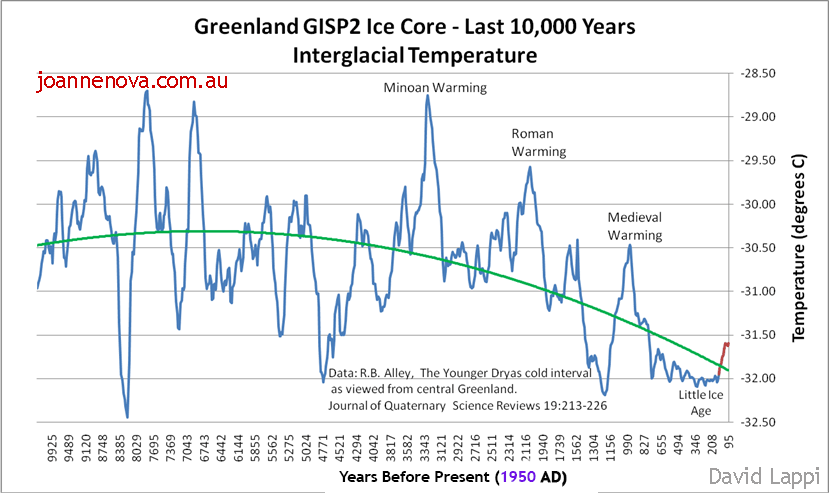 UPDATE: This graph shows the ice-core data up until 1855. The last 150 years (1705 to 1855) are highlighted in red to show the warming as the Earth began coming out of the LIA. Western Australia is one of the oldest and most stable parts of Earth, making it an ideal place to study sea levels. We’re worried about seas rising by 3mm a year (and only after the satellites were “adjusted”) but the oceans rose 125 meters, stayed high for thousands of years and have been falling for most of human civilization.
Save the world from witchdoctors. Teach children geology and the history of the Earth.
___
PS: Any miners reading this with photos of Marble Bar they don’t mind me using? Please send them in. There are surprisingly few photos available on any copyright-free libraries. Somewhere out there someone must have a photo of shimmery heat rising off bitumen!
REFERENCE:
Lewis, S.E., et al., Post-glacial sea-level changes around the Australian margin: a review, Quaternary Science
Reviews (2012), http://dx.doi.org/10.1016/j.quascirev.2012.09.006 [abstract] (paywalled).
9.9 out of 10 based on 81 ratings
8.2 out of 10 based on 12 ratings
8 out of 10 based on 21 ratings

by Jo Nova
When will the Green climate activists realize they are the minions of the Banksters, and communist governments?
In 2021 BlackRock used its shareholder influence to force Exxon to drop some gas fields under the guise of “climate activism”. BlackRock were the second largest shareholder with 6.6% of Exxon at the time. They bragged about getting three new activist board members elected to help Exxon in the “energy transition”. But they also happened to be major investors in PetroChina too with 7% of the Chinese oil and gas company and BlackRock didn’t seem to care too much about their ESG policy. Conveniently, PetroChina was “poised” to buy many of the fields that the giant US oil company was getting its arm twisted to sell.
Naturally the Stupid-Media wrote this up as a win for koalas and whales or something:

It’s like sabotage of national assets
While BlackRock pretend to care about the environment, they were potentially undermining a US company, their US shareholders, and own pension fund clients, all to get a better deal, perhaps, with “favours” of who-knows-what for a foreign company, which is a subsidiary of the Chinese State CNPC. We can only speculate, but the conflict of interest is ripe with possibilities. It’s easy to imagine President Xi being grateful. And as it happens, BlackRock became the first to operate a wholly owned China mutual fund in June 2021. Coincidence?
Thankfully, two US State Republican governments noticed the conflict of interest, and put pressure on BlackRock and other pension fund managers. The Wall Street Journal article below is a year old, but under the fiduciary duty headline, many people may have missed the detail about PetroChina being the winner, and about BlackRock’s “environmental attitude” being so anti-West and pro-China.
By Jed Rubenfeld and William P. Barr, Wall Street Journal, Sept 6th, 2022
 Last week Attorneys General Jeff Landry and Todd Rokita of Louisiana and Indiana, respectively, went further. Each issued a letter warning his state pension board that ESG investing is likely a violation of fiduciary duty. Last week Attorneys General Jeff Landry and Todd Rokita of Louisiana and Indiana, respectively, went further. Each issued a letter warning his state pension board that ESG investing is likely a violation of fiduciary duty.
The Louisiana and Indiana opinions didn’t make headlines but have seismic implications: They suggest that state pension-fund board members, investment staff and investment advisers may be liable if they continue allocating funds to ESG-promoting asset managers such as BlackRock.
First, Mr. Landry’s guidance spotlights potentially explosive, undisclosed conflicts of interest in the Big Three’s “selective” promotion of ESG criteria against U.S. companies but not Chinese companies. According to Mr. Landry, in 2021 BlackRock exercised its proxy voting rights as Exxon’s second-largest shareholder to lead “an activist campaign that forced Exxon to cut oil production,” without disclosing that many of the “oil fields dropped by Exxon” are “poised to be acquired by PetroChina” and that BlackRock is “one of PetroChina’s largest investors.”
Mr. Landry has a point. BlackRock has an enormous stake in PetroChina, reporting holdings of between one trillion and two trillion shares, representing between 5% and 10% ownership, from 2018-22.
The US Republican states may yet save us. We know this campaign has been successful in slowing the ESG trainwreck. One giant fund, Vanguard, pulled out of the global banker cabal in December last year. The Insurance fund consortium has largely fallen apart. Larry Fink (the CEO of BlackRock) has stopped bragging about ESG, and BlackRock has closed one small China fund just last month, after such pressure.
The dark bubble is the reason everything seems to be going off the rails simultaneously.
Are your retirement funds being used?
Photo by eflon on Flickr. Adapted. CC by 2.0.
9.7 out of 10 based on 89 ratings
9.4 out of 10 based on 8 ratings
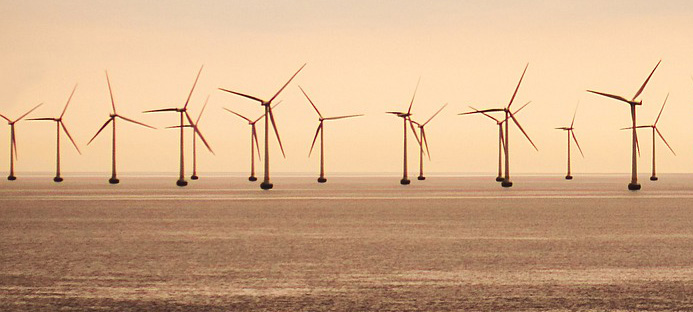
They’re not much use without a lot of cabling. | Image by Norbert Pietsch from Pixabay
By Jo Nova
Thanks to Oldbrew at Tallblokes Talkshop
Who knew high voltage cables running for kilometers in a deep electrolytic moving body of water would be expensive?
Despite offshore windfarms dealing in a kind of mechanical hell of high speed salt water spray, big waves and volatile wind conditions, surprisingly 85% of the insurance claims are because the underwater cables are failing.* If the subsea cables can’t be insured, it’s another unexpected cost threatening the economics of offshore wind.
The underwater cables needed for offshore wind are apparently so costly to repair, and the losses from lack of generation so steep, they are in danger of becoming uninsurable.
Energy News Live
The race to harness offshore wind energy has hit a significant roadblock, with the reliability of subsea cables emerging as a critical concern.
Global Underwater Hub (GUH) has raised alarm bells about the escalating issue of subsea cable failures.
These setbacks not only disrupt power transmission but also incur hefty costs.
Imagine if an entire coal plant was connected to the grid through one long cable buried under the ocean and when the cable failed it took months to find and repair — during which time the plant could not earn a cent…
World Oil
GUH chief executive, Neil Gordon, said, “It’s estimated that around 85% of the total value of offshore wind insurance claims relate to subsea cables. Insurers are losing money underwriting cables with the average settlement claim in the region of £9 million. Brokers have warned that the high number of cable claims is affecting capacity and coverage and the cost of repairs typically runs into millions, with warranties rarely covering the high cost of business interruption.
“If these critical components become uninsurable, offshore wind projects around the world will be derailed, making global 2050 net zero targets completely unachievable.”
According to one developer, the cost of insuring a 1.2GW offshore wind farm over its lifetime is in the region of £350 million and insurance brokers estimate that the costs of floating offshore wind will be 30% higher than fixed bottom ones.
Global Power Marine fixes export cables and quotes one happy customer talking about needing “only” 32 days instead of 67 days to repair the cable. But all the while, part or all of the wind plant isn’t earning any income, and so much of any repair depends on getting good weather so a ship can hover and work uninterrupted while the cable is “dangling” and exposed.
Gulski et al estimate the duration of failure can be 1 to 3 or even up to 9 months:
“Last 20 years of experience shows that the power cables are the largest contributor to the failures of power supply from the offshore plants. “
For those who want the details on the challenges of engineering Gulski et al detail some of the problems with subsea cables like the need for armour that isn’t magnetic, sections that are 30-50 kilometers long to avoid “joints” underwater, and why most cables on the sea floor are called “wet structures” which allow water in (at least to the outer layers).
Wind energy might be free, but collecting it costs the Earth.
Late Update — Australia desperately needs to learn these lessons
Prompted by comments from David Maddison and Ross below:
There are no offshore wind plants in Australia but we are rushing to build them, so the tales of woe from the UK and US are especially relevant here now.
The Basslink Cable from Tasmania to mainland Australian has broken not once, but three times here in the last seven years. First in 2016 for 5 or 6 months (I believe Australia didn’t even have the right repair ship, we used the Ile De Re which was based in Jakarta). Then the cable was out again in 2018 for two months. And in 2019 for another month due to a problem on land at the Victorian end.
The Basslink repair in 2016 were delayed for weeks because of bad weather.
After three weeks of delay, the ship was finally able to leave Geelong last night and the repair team hopes calm conditions will last long enough to connect a new section of cable to the existing one. The repair team needs 16 calm days to work on the cable before it can be up and running again.
How could our BOM even predict 16 calm days on the Bass Strait…?
_______________
*Admittedly, this percentage may be high because insurance companies don’t cover most of the other kinds of failures on wind “farms”, as we see with Siemens massive stock loss as they realized the true cost of maintenance.
9.9 out of 10 based on 101 ratings
10 out of 10 based on 10 ratings
Apologies, Thursday went someplace else.
9.3 out of 10 based on 10 ratings
By Jo Nova
And you thought your last software crash was bad
Brian Morrison ended up a prisoner in his own new MG electric car that wouldn’t stop. He could steer, but the brakes didn’t work, and he couldn’t turn it off. At one point he threw the car keys into the police van driving beside him, which had come to help, but even that didn’t stop the motor. This was not meant to be a self-driving car.
Tragedy was averted this time because it was 10:30 at night, the road was empty and the police had time to stop it. But what if this fault occurred in normal traffic and the EV drove through a red light, or a pedestrian?
By Rory Tingle at The Daily Mail:
Terrified motorist, 53, reveals his new £30,000 MG ZS EV ‘began driving itself’ after suffering ‘catastrophic malfunction’ – forcing him to dial 999 and crash it into a police van to get it to stop
Brian Morrison, 53, claims he was heading home from work at around 10pm on Sunday when his new Chinese-made fully electric car began driving itself at 30mph.
‘I have mobility issues, so I couldn’t even jump out – I was completely trapped inside the car going at 30mph.
‘So eventually three police vehicles arrived and were driving in front of me and behind me.
Mr Morrison said: ‘After trying to shut the car down, my entire dashboard lit up with faults, and then it all went away after a second and just had a big red car symbol that said “drive safely, stop driving immediately” or something.
After the car was forcibly stopped it still launched itself forward if given the chance. The RAC mechanic plugged in his diagnostic machine and declared it had “pages of faults” and wasn’t game to turn the engine on.
Before we thank our lucky stars that it worked out OK, we have to ask: how do we know this hasn’t happened before? It was the first time the emergency call centre had dealt with this issue, but if the EV had crashed and killed the driver before they could call, would the accident investigation squad even look for software bugs, or would they just say “they ran the red light”?
David says: “Never trust a computer you can’t throw out the window”.*
Coming soon to electric cars:
Imagine if we brought 100,000 two-ton vehicles from a foreign adversary…
h/t Dennis
*A quote from Steve Wozniak.
9.6 out of 10 based on 100 ratings
8.3 out of 10 based on 18 ratings
By Jo Nova
Remember how we predicted insurance costs would rise when people realized that almost brand spanking new EV’s were being written off for scratches, because no one could test their battery and be sure it would not ignite? And then there was the news that after an accident, electric cars need to social distance, taking up as much as 50 times as much parking space, in case they blow other cars up? Well, insurance companies have realized this too. One underwriter has paused offering EV’s insurance entirely, while other companies are ramping up the rates by 60 – 900%. What a shock:
Zoe Wood, The Guardian
In the Facebook group, members share stories of horror renewal quotes, with increases ranging from 60% (up to £1,100) to a staggering 940% (a jump from £447 to £4,661, according to a screengrab shared by one driver).
“I spent weeks on every comparison site as well as trying individual insurers and specialist brokers, but either they wouldn’t cover the car or the quotes were £5,000 or more,” says David, whose only change in circumstance was three points on a licence.
Privilege, Vitality, Axa and the specialist broker Adrian Flux were among the brands he found were “unable to insure him at this time” before he nailed down a policy with Direct Line, albeit at a price.
Analysts say claims costs are 25% higher for electric cars, and that they also take about 14% longer to repair than a diesel or petrol equivalent.
One former BBC reporter Alex Gerlis bought an EV, insured it with John Lewis, only to find after a year John Lewis said it had stopped insuring EV’s altogether. Gerlis thought this “flew in the face” of the company saying it wanted to fight climate change and complained. This may have been the first time he realized that not everyone who “wants to fight climate change” is happy to lose their money on it.
If you own an EV and it is insured, you might be lucky if someone were to run into it in the car park.
h/t NetZeroWatch
9.8 out of 10 based on 135 ratings
8.4 out of 10 based on 19 ratings
8.5 out of 10 based on 10 ratings
By Jo Nova
Three labs confirm fragments of DNA from manufacturing are left in the mRNA vaccines
We injected 70% of the world’s population with a barely tested admixture that included random lengths of DNA. We don’t know for sure if that DNA has been inserted into our nuclear DNA, but we’re not really looking either. The government just says mRNA can’t change your DNA. But could contaminated mRNA which is packaged in lipid nanoparticles, with gene therapy vectors and enhancers do that? Maybe, but whatever you do, don’t run those tests, right?
Are we changing germline genetics of the human race — getting into sperm or egg cells? We don’t know. These are just the games we play these days. We could easily have run those tests on sperm at least, before we approved anything in young fertile adults and children, but we didn’t. A Chinese scientist that did that once in a different experiment ended up in jail. Some researchers are quite concerned to put it mildly. The odds may be low, but the numbers are astronomical. After a few billion hands of poker everyone has a Royal Flush.
In March, Kevin McKernan, a molecular biologist, found DNA contamination in Pfizer’s mRNA Covid vaccines and published this in here and here. As soon as Kevin McKernan put out his paper on the presence of small fragments of SV40, the Factcheckers arrived to flood the scene with strawmen — declaring there’s no SV40 virus in vaccines — which is true, but no one said there was.
Now the presence of remnant DNA has been confirmed by two independent labs (Dr. Sin Lee and Philip Buckhaults) — so it wasn’t a freak finding or a mistake. It really is that bad. Indeed, Phillip Buckhaults set out to show the fears were overblown but instead, in astonishment, confirmed what McKernan found.
“My plan was to examine the vaccine to debunk the fear of SV40 being in the vaccine. … I checked them first by a PCR assay that uses primers against the vector, and lo and behold, it fired very hot. A very, very high signal. … and son of the gun, Kevin McKernan was right, this plasmid is present in the vaccine. I proved that there is NOT SV40 full virus, but there is plasmid DNA. And that plasmid does have a little piece of SV40 in it. “
— Phillip Buckaults interview with Maryanne Demasi

A plasmid is a circle of DNA that’s a regular lab tool. In this case it contains about 10% of the SV40 virus, a virus that contaminated some polio vaccines around 1960, and has been the subject of many studies since. We find it in cancer cells, but did it cause the cancers? Academic opinion is divided (see the papers here). But the part of SV40 that’s in the plasmid is a potent part that amplifies or promotes whatever code follows it. Indeed, SV40 is used in gene therapy research — it makes a good vector. It’s such a good gene therapy tool that the residual DNA contaminant ought to be classified under gene therapy regulations instead of vaccination rules, says McKernan. He points out that there is an ongoing lawsuit in Australia with the TGA about this very issue.
The mRNA vaccines are an incredibly complex chemical product — easy to screw up
Creating mRNA vaccines was a monumentally ambitious chemical task. It’s no wonder things went wrong. An mRNA molecule is a chain of four different small molecules that is 4,284 bases long, in an exact sequence in the correct order. Effectively, on a molecular scale, we must connect these 4,284 nucleic acid bases in a row, and then wrap them in a fat layer (called a lipid nanoparticle). McKernan estimates each vaccination dose contains 13 to 40 trillion copies of the mRNA. This is not like the complexity of chemistry, say, used in creating ammonia in the Haber Bosch process, but something leagues, astronomical magnitudes beyond that. It is only possible because a billion years of evolution has crafted nano-scale machines that do a lot of it for us. We are merely co-opting the tools of biology. Grinding out thousands of bases is something even bacteria can do, but cleaning it up, that’s much harder.
To create all the copies of mRNA, and package it up, we use E.Coli — a bacterium — to be the molecular factory, then we have to strip out those factories, to disassemble them and all their “body parts” and remove them, without damaging the product, and in some batches we failed miserably.
Once again, we all hope friends, families and readers here, of course, got the good batches. It was a lottery.

The best interview covering this is with the Epoch Times: American Thought Leaders Interview
I recommend watching it at the link, or reading the whole transcript there. (I don’t think it is paywalled, but if you can’t play it, Brenda suggests this Rumble video version. These are excerpts below:
Kevin McKernan Talks COVID Vaccine DNA Contamination, the Monkey Virus SV40 Promoter, and What’s Actually in the Vaccines
… many years ago there was a case where Dr. He in China did some genome edits on two babies. He made two CRISPR [clustered regularly interspersed short palindromic repeats] babies. That guy went to jail. Fast-forward to today, we’re willing to take that risk on billions of people. Now granted, CRISPR is a lot more effective, and doing it on germline is obviously going to affect every cell in the kid’s body. We’re probably not going to get every cell in the kid’s body when we inject them with one of these vaccines.
But if we hit a stem cell or if we hit a germline cell with a vaccine and we get an integration event, it’s effectively what that guy did, and it put him in jail. The ethical decay that’s occurred in the last five years in the biomedical community is absolutely astonishing. I can only attribute that to the vast amount of money that’s on the table for these vaccines.
What we do know is there is residual DNA in both shots, and this DNA is either right above the regulatory limit or tenfold higher. Our data has shown it to be tenfold higher than the FDA’s standards.
Why did we need such high doses? “… an RNA molecule for every single cell in your body.”
The RNA is just supposed to make enough protein to teach some white blood cells, not to teach every single damn cell in your body:
But what I think was perhaps a valid critique of their effort is that they never really knew how much you needed. Their dosage study looked at three doses. Why are we injecting 40 trillion of these things into people?
Why does the immune system need such a huge payload to build an immune response? … we’re putting in truckloads of this material.
We’re doing it over and over and over again, and it’s not working. These are all signs that something is horribly wrong. There’s 30 trillion cells in your body, so there’s more than an RNA molecule for every single cell in your body.
Would you like factory DNA in your ovaries?
We know from the biodistribution study that some of these LNPs are getting to the ovaries, so that’s a huge concern. If 1 percent of these LNPs get to the ovaries, there’s 40 billion in each shot, we’re getting down to 400 million that go to the ovaries. Now you’re starting to really concern yourself. If there’s only 300,000 oocytes in each female, and there are 400 million LNPs down there, these numbers are worrisome. What are we doing to the germline in the future generation?
(These numbers didn’t quite tally. Some studies estimate each LNP ball has on average 5 mRNA’s. So 40 billion LNP’s won’t carry 40 Trillion mRNA’s, as McKernan stated above. Perhaps the transcription tool “misheard”, or a reader can explain — either way, the important point stands. Human eggs are precious things, a million or a billion accidents either way is awful).
We don’t know where the vaccines went in body tissues:
This would seem the most basic first step, but we didn’t even do it properly.
Mr. McKernan: There were a lot of things they told us were impossible, which turned out not to be true. I would like to see more biodistribution studies. The biodistribution studies were not run with the mRNA that’s being injected. They ran it with a mock mRNA known as a luciferase mRNA that doesn’t necessarily give you the best signal to detect this over long periods of time.
They also ran those biodistribution studies over very short time windows. Of course, now we’re seeing mRNA in people’s plasma 28 days later, and we’re seeing it in breast milk. We’re seeing the spike protein in monocytes four months later. The biodistribution studies really didn’t track this long enough to know where it goes and for how long.
A cocktail of contaminants
The contaminants include not just a part of a monkey virus, but also antibiotic resistance, and also something called a 72 ACE pair enhancer which is apparently good for moving DNA into the nucleus (Oh no).
Mr. Jekielek: Let’s talk about what we know concretely. Please explain why you might have this SV40 promoter and enhancer in there in the first place.
Mr. McKernan: It’s a common tool used in the biotech industry to drive very aggressive expression of a gene. In this case, Pfizer has it in front of a neomycin resistance gene, which drives resistance for neomycin. The reason they want it there is so that they can grow this plasmid in E.coli. E.coli doubles every 30 minutes, so you can grow E.coli overnight and get gobs of this DNA. You then have to purify it from E.coli to make RNA out of it.
Fragments of DNA — especially ones packaged the right way — could integrate into our own genetic code. They may do nothing or everything depending on where they “land” in our 3.2 billion base genome. They may cause cancer if they land inside a key gene that usually protects us against cancer.
The concern is if this DNA integrates the genome, one portion of the SSV40 sequence is an SV40 promoter, a very strong promoter, which means it drives transcription wherever it lands in the genome. If this happens to drop itself in front of a proto-oncogene and drives a lot of expression off of a gene that’s known, if you hyper-express it and turn the cell cancerous, then we have a concern that DNA is in fact doing that.
Normally it’s difficult for loose bits of DNA to get near the nucleus of our cells where our DNA is kelp. But if the DNA is packaged up and has the right equipment, it can get there:
There are two concerns. There are promoters in this vaccine from SV40 and there’s an 72 ACE pair enhancer, which David Dean has shown is a very potent tool for moving DNA into the nucleus, and they’re right next to each other. If this DNA moves into the nucleus and it drags a promoter with it, and that integrates in front of a gene, it can disrupt gene regulation and potentially lead to the oncogenesis.
Pfizer hid the SV40 component from the EMA
This is a really bad look:
The really crushing thing here is Pfizer never disclosed the SV40 information to the EMA [European Medicines Agency]. They gave them a plasmid map of what the plasmid consisted of, with all of the features labeled, with the exception of the SV40 site.
They did that because they know the SV40 region is a very controversial base in its history in the vaccine field. The polio vaccines were contaminated with the full virus, not just these little components, but the full virus. The full virus has over 5,000 bases. The components we have are about 466 bases of the virus, but they’re arguably the most functional aspects of the virus’s genome for replicating and for gene expression.
The fact that they hid that this is in there from the EMA is a concern. We know from David Dean’s work that it’s used as a gene therapy tool, so it would clearly classify the residual DNA in the vaccines under the gene therapy regulations that we have in many jurisdictions.
Fragments of DNA that integrate may do nothing or everything depending on where they “land” in our 3.2 billion base genome. They may cause cancer if they land inside a key gene that usually protects us against cancer. All our cells have multiple layers of protection against cancer, but this may wipe one of them out.
Stop vaccines for children and adults of fertile ages until we know
If the DNA of eggs and sperm is being changed — it may mean the death of that particular embryo, which may delay pregnancy but not preclude it. It could translate into falling fertility rates, or it may mean children born with a higher risk of disease or disability. We may be playing “shotgun” genetics with the next generation. Why aren’t our Ministers of Health looking? It would be easy to analyze sperm samples and answer this question. It’s a lot harder to test eggs. It’s the sort of test that could be done in weeks.
Now that the DNA contamination is known, the question of culpability and informed consent gets so much more pointed. But for our regulatory agencies — the question remains — why didn’t test for this at the start of 2021?
What kills much faster than cancer? — “endotoxins”
McKernan admits that bacterial endotoxin contamination scares him more than the DNA — at least in an immediate sense. The remnant shells of the bacteria — the body parts of E.Coli — are called lipopolysaccaride, or LPS, and they are highly allergenic. We deal with small doses of this all the time, but in large doses, they can cause anaphylaxis — the potentially deadly overactivation of our immune systems. Just this contaminant alone may have caused sudden deaths within minutes of injection.
There is some risk that if you don’t fully purify it from E.coli, you can leave behind what’s known as endotoxin or lipopolysaccharides, usually abbreviated as LPS. This is an additional risk that Pfizer took on. Moderna’s doing a very similar thing, although they don’t have SV40 in there. They are using E.coli to amplify their plasmid DNA, and it comes with some of this risk.
The good news is that if the endotoxins didn’t kill you, at least that risk is gone, unless you have a booster.
Cherry picking the tests to pass outdated regulations
The European Medicines Agency (EMA) sets a safe ratio of RNA to DNA (well, they say it’s safe), but the pharmaceutical companies cherry picked the type of tests they used, so as to overestimate one and underestimate the others and “pass”. How much do any of them care about your health?
The EMA has a different standard that’s a ratio metric standard. When looking at RNA to DNA ratios, it’s even worse. The actual outcome is that there is more like a 17 to 80-fold gap from what is required in the regulations, as best we can tell.
I’ve only seen Pfizer’s documentation on this, but when they are measuring this and giving data to the regulators, they’re using two different tools to measure the RNA versus the DNA. That’s a mechanism for them to cook the books here. They shouldn’t do that. There’s tools like qPCR that can measure both DNA and RNA, but instead they’re measuring the RNA with fluorescence like a qubit or a fluorometer, and they’re measuring the DNA with qPCR. That inflates the amount of RNA they get and depresses the amount of DNA they get so that they can squeak through these regulatory requirements without anyone really understanding what’s going on.
Coding for the nerds
Lastly, this, below, is just a part of the code for the plasmid DNA contaminants in the mRNA vaccine. Click to enlarge. The A, C, T and G stand for molecules called adenine, cytosine, thymine and guanine. Think of this as the C++, or Python of biology. Given the current state of play, perhaps it’s worth becoming a bit more familiar with molecular biology.
It is double stranded — and in the alternate chain, which is effectively a back up “mirror” copy, we see C always pairs opposite G and T always sits opposite A. This is exactly the same as our DNA — same bases, same language. Our cellular machinery will potentially engage and read this code and produce the products — whatever they are.
—————————————————
hat tip: John Connor II, Leo G, Konrad, Ian B, bella.
Kevin McKernan’s blog is Anandamide
Kevin McKernan1*, Anthony M. Kyriakopoulos2 and Peter A. McCullough3 (2023) Differences in Vaccine and SARS-CoV-2 Replication Derived mRNA: Implications for Cell Biology and Future Disease, Submitted for peer review. [DocX] (page 11)
Bacteria image by Spaully
9.8 out of 10 based on 81 ratings
8 out of 10 based on 23 ratings
8.8 out of 10 based on 17 ratings
|
JoNova A science presenter, writer, speaker & former TV host; author of The Skeptic's Handbook (over 200,000 copies distributed & available in 15 languages).

Jo appreciates your support to help her keep doing what she does. This blog is funded by donations. Thanks!


 Follow Jo's Tweets
Follow Jo's Tweets To report "lost" comments or defamatory and offensive remarks, email the moderators at: support.jonova AT proton.me
Statistics
The nerds have the numbers on precious metals investments on the ASX
|



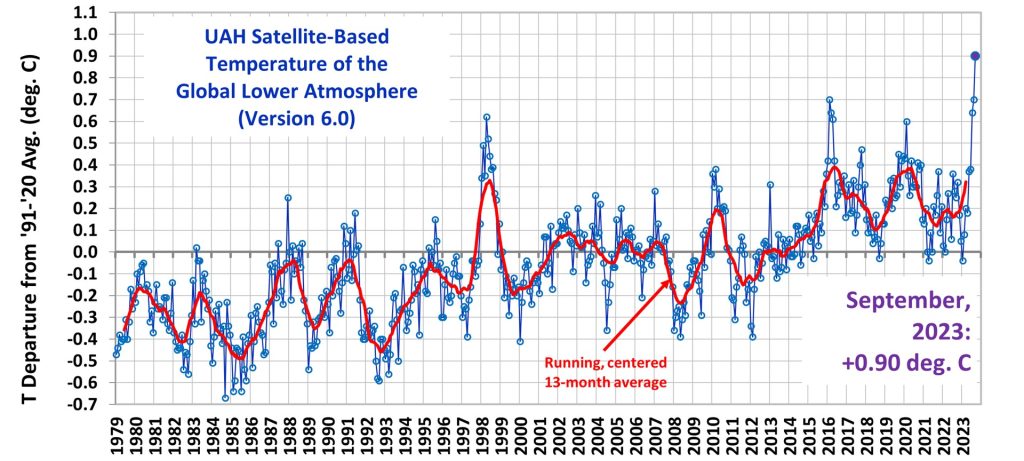


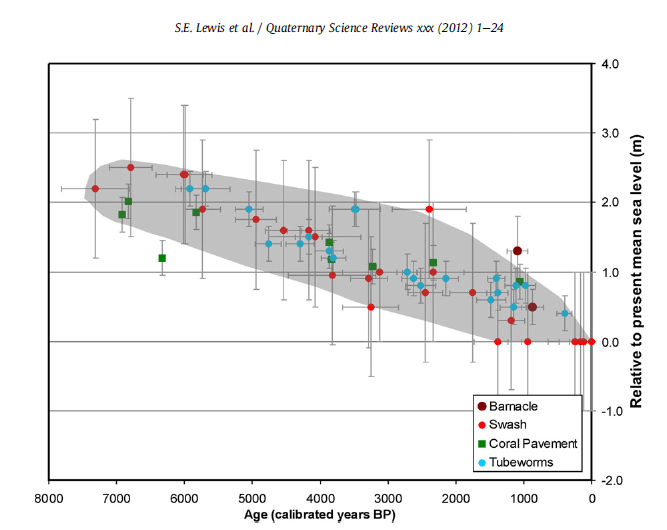


 Last week Attorneys General Jeff Landry and Todd Rokita of Louisiana and Indiana, respectively, went further. Each issued a letter warning his state pension board that ESG investing is likely a violation of fiduciary duty.
Last week Attorneys General Jeff Landry and Todd Rokita of Louisiana and Indiana, respectively, went further. Each issued a letter warning his state pension board that ESG investing is likely a violation of fiduciary duty.

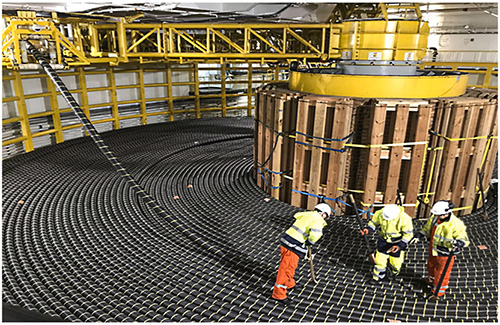
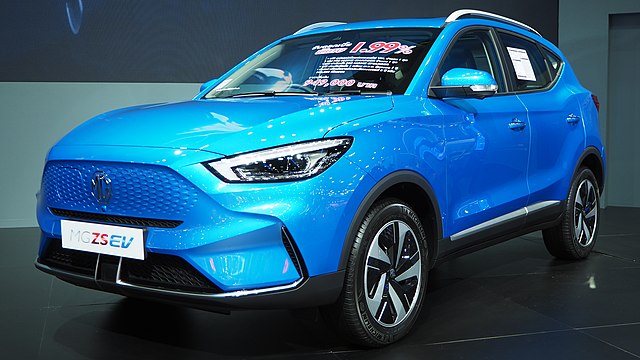
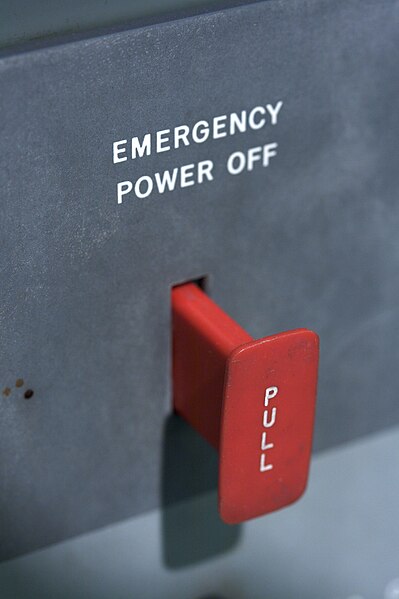
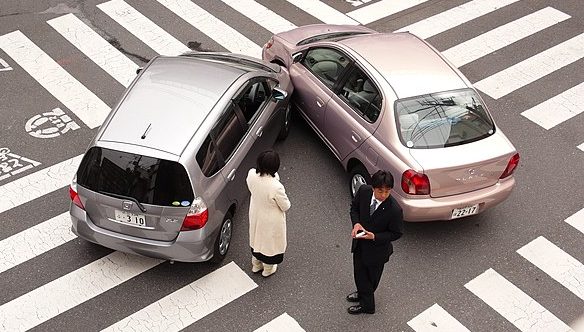



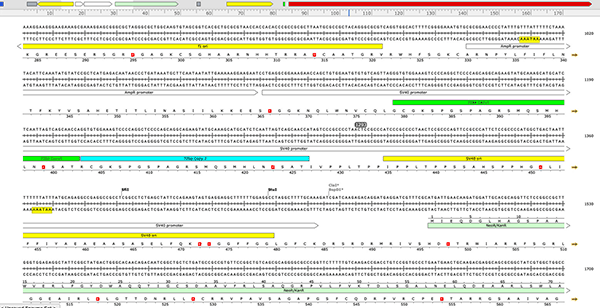




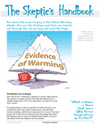






UPDATE #2: Allegedly there were no sprinklers (which wouldn’t put out an EV battery fire anyway). Let’s try to imagine what kind of sprinkler system would contain those EV Fires — like drop-down glass-fibre spray that solidifies on contact or like jet sprayed asbestos?
UPDATE #3: As many as 1,500 cars were in the car park, it’s not clear how many survived. Fireman say all four floors pancaked in at least one part. *See the video of the supposed start of the fire. And footage where the car is visible. Seems like a very big explosion. Some are saying it was a hybrid diesel.
Let your imagination run …